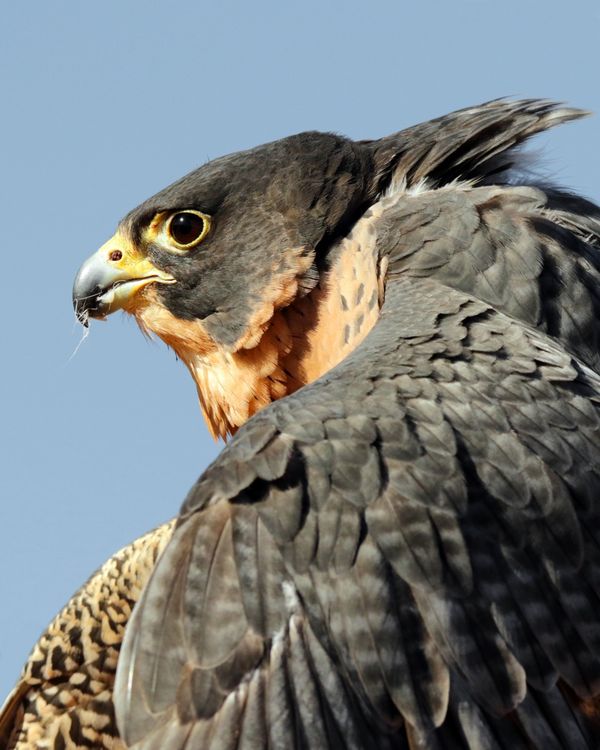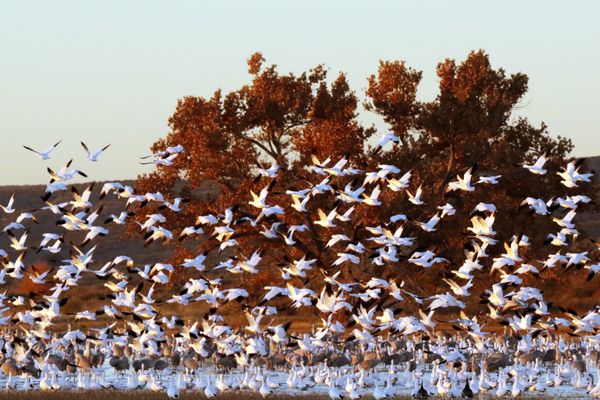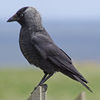Bird photography
Nov 29, 2014 12:12:30 #
I have a Sony A57 (1.5X crop sensor & 16M pixels) and a Sony A99 (full sensor & 24M pixels). Both camera deliver very sharp pictures of birds, but the A57 has extra reach due to the crop factor. If I crop the full sensor down to the same shot as the crop sensor, I am throwing away pixels -- 24M / 2.5 = 9.6M pixels in use.
For distant objects, there is only one place the full frame does better and that is low light with noise. I can shoot at higher ISO values without producing visible noise.
But when using the same lens on the two different bodies, the crop sensor will give an effective 1.5x reach.
And one more obvious difference. If I am not using a really good lens, the crop sensor really only uses the center of the lens and is effectively already acting like a stopped down lens. This can mean that I might not need to stop down as much for sharpness.
I also did an experiment where I borrowed one of those cheap $300 Vivitar 800-1600 zooms that you see advertised. The focus was super critical and it was a real problem to find good focus. The lens was also subject to a lot of vibration. It was a lot easier at 800mm than at 1600mm and I have to conclude the 1600mm end was esentially useless. The full senor was easier to focus and the crop sensor was ridiculous to focus. I did surprise myself at how good a photo could turn out on a stationary, non moving object with a little help in post processing to boost contrast. But I would not want to ever go birding with one of those lenses with either camera.
For distant objects, there is only one place the full frame does better and that is low light with noise. I can shoot at higher ISO values without producing visible noise.
But when using the same lens on the two different bodies, the crop sensor will give an effective 1.5x reach.
And one more obvious difference. If I am not using a really good lens, the crop sensor really only uses the center of the lens and is effectively already acting like a stopped down lens. This can mean that I might not need to stop down as much for sharpness.
I also did an experiment where I borrowed one of those cheap $300 Vivitar 800-1600 zooms that you see advertised. The focus was super critical and it was a real problem to find good focus. The lens was also subject to a lot of vibration. It was a lot easier at 800mm than at 1600mm and I have to conclude the 1600mm end was esentially useless. The full senor was easier to focus and the crop sensor was ridiculous to focus. I did surprise myself at how good a photo could turn out on a stationary, non moving object with a little help in post processing to boost contrast. But I would not want to ever go birding with one of those lenses with either camera.
Nov 29, 2014 16:55:59 #
Rufus
Loc: Puget Sound area, WA
One of the recent notes contains a statement that I believe could be misunderstood. The entire "crop sensor" is illuminated by the aperture that is 'open' on the lens and it determines the sharpness, not that the sensor is smaller than full-frame.
Jim
Jim
Nov 29, 2014 17:10:59 #
Rufus wrote:
One of the recent notes contains a statement that I believe could be misunderstood. The entire "crop sensor" is illuminated by the aperture that is 'open' on the lens and it determines the sharpness, not that the sensor is smaller than full-frame.
Jim
Jim
Correct- a FF lens will give better resolution when a stop or two down from wide open, even on a 'crop' sensor. The difference is just less obvious, as for most lenses resolution is worse at the edge of the image, which is not projected onto the 'crop' sensor.
Nov 29, 2014 23:24:40 #
Falcon boy wrote:
currently I have been using a Nikon D 7000 for photographing birds. Would I have the potential for better photos with a full frame Nikon body?
Falcon, here are three images taken with a cropped sensor body (7D mkII. I also own a 5D mkIII (full sensor) but definitely prefer the cropped sensor for wildlife. These images were taken with the Tamron 150-600mm lens on the 7D mkII. The added magnification far exceeds the added pixels of a full sensor body ... in my humble opinion. I will admit I use the full sensor body for hummingbirds and butterflies. Which ever way you go, you'll have fun as long as your glass is good. Best, J. Goffe
@ 300mm

@ 250mm

@ 600mm

Nov 29, 2014 23:38:59 #
I shoot with a crop sensor body, and have since I started with digital photography 7 years ago (originally a Canon 40D, now 50D).
IMO, the lens is much more important than the highest resolution camera body in determining the quality of a bird image.
Here's a link to my featured bird images, to give you some idea of what a crop sensor body (that's now 5-6 years old) can still do:
http://allenh.zenfolio.com/p882622938
IMO, the lens is much more important than the highest resolution camera body in determining the quality of a bird image.
Here's a link to my featured bird images, to give you some idea of what a crop sensor body (that's now 5-6 years old) can still do:
http://allenh.zenfolio.com/p882622938
Nov 30, 2014 05:15:44 #
Allen Hirsch wrote:
I shoot with a crop sensor body, and have since I started with digital photography 7 years ago (originally a Canon 40D, now 50D).
IMO, the lens is much more important than the highest resolution camera body in determining the quality of a bird image.
Here's a link to my featured bird images, to give you some idea of what a crop sensor body (that's now 5-6 years old) can still do:
http://allenh.zenfolio.com/p882622938
IMO, the lens is much more important than the highest resolution camera body in determining the quality of a bird image.
Here's a link to my featured bird images, to give you some idea of what a crop sensor body (that's now 5-6 years old) can still do:
http://allenh.zenfolio.com/p882622938
Allen, your shots are excellent!
But you have to admit, a cropped sensor does have its limitations, particularly when you need to crop and then print the image. You can always crop an image to fill the screen of a computer (2000x1300 or so), but you may need more pixels than that to make a decent large print. There are quite a few images in your collection that say they cannot be printed at 16x20 or larger, though they look incredible on my display.
Though to be honest, , how much resolution is needed for a large print is still a hot topic for some. I believe Mpix does limit print size for certain images for some customer satisfaction related "matter" they may have experienced in the past. However, a 3000x2000 image will provide excellent image quality for an image beyond 24x36 - when you take viewing distances and the human eye's resolution limit, which diminishes inversely with increasing distance. I have several images taken with a D70s, a 6 mp cropped sensor camera, that have been printed at 24x36 and look great.
The advantage of having a full sensor, especially the newer ones with greater pixel density, is that you can crop and still have plenty of pixels left for good prints.
Nov 30, 2014 11:24:13 #
Thank you, Gene.
I've never experimented with a full frame sensor for bird photography. My sense is (which may now be incorrect as sensors and resolution improve), what I gain in more pixels I lose in needing to crop further for the same effect if it's full frame instead of a crop sensor - so I net out to about the same place (for a given lens focal length).
I have printed a number of my images 16 x 20 with no problem. OTOH, I've tried to use some closely-cropped images in calendars and I've been warned by the vendor that the resolution wouldn't support an image that size.
I've never experimented with a full frame sensor for bird photography. My sense is (which may now be incorrect as sensors and resolution improve), what I gain in more pixels I lose in needing to crop further for the same effect if it's full frame instead of a crop sensor - so I net out to about the same place (for a given lens focal length).
I have printed a number of my images 16 x 20 with no problem. OTOH, I've tried to use some closely-cropped images in calendars and I've been warned by the vendor that the resolution wouldn't support an image that size.
Nov 30, 2014 12:58:59 #
Gene51 wrote:
Allen, your shots are excellent! br br But you ha... (show quote)
I will tell you I use Canon 60D, 50D and Sony A3000. I make my images 160 PPI and printed by Fine Art America, the results are stunning at 36 inches wide. Fine Art America guaranties print satisfaction down to about 135PPI ! I do not know how they do it ( special software ? ) - but it WORKS .
Dec 3, 2014 23:07:12 #
Thanks so much for your feedback. It usually comes back to the quality of the glass. My explanation of better pics refer to obtaining clearer images of birds especially in low light conditions especially living in the ever sunny nortwest😄
Dec 3, 2014 23:13:23 #
Thanks for taking the time to reply. Currently I am using the same lens on my Nikon D 7000. It certainly makes sense what you are saying.
Your photos are beautiful . Are you using a aperture priority to capture these images?
Thanks
F Boy
Your photos are beautiful . Are you using a aperture priority to capture these images?
Thanks
F Boy
If you want to reply, then register here. Registration is free and your account is created instantly, so you can post right away.





